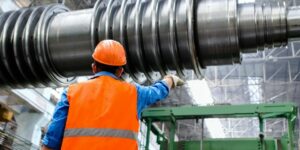Regenerative thermal oxidizers (RTOs) are a leading solution for controlling volatile organic compounds (VOCs) and hazardous air pollutants (HAPs) from industrial air pollution sources. These systems can achieve up to 99% efficiency in destroying harmful emissions, making them a popular choice across various industries.
However, despite their high efficiency in reducing pollutants, RTOs face a significant challenge: the high cost of fuel. The substantial temperature (1500 – 1750°F) required to eliminate VOC’s, hydrocarbons and carbon monoxide from an emission stream within RTOs results in considerable annual fuel expenses, posing a financial burden on operations.
To address this issue, incorporating catalysts into the regenerative oxidation process offers a promising solution. Catalysts enable chemical reactions to occur at lower temperatures, significantly reducing fuel consumption. This not only lowers operational costs but also enhances the overall efficiency of the emission control system. By converting RTOs to regenerative catalytic oxidizers (RCOs), industries can achieve substantial cost savings and improve their environmental footprint.
Benefits of Converting RTO to RCO

Operating on the principle of thermal oxidation, RTOs effectively combust pollutants by subjecting them to high temperatures in a combustion chamber. However, this high-temperature operation results in a certain level of energy consumption, which can lead to substantial operating costs over time.
Enhanced Efficiency with RCOs
Regenerative Catalytic Oxidizers (RCOs) represent a technological advancement over traditional RTOs. RCOs combine the benefits of regenerative heat exchangers with catalytic oxidation to achieve enhanced efficiency and cost-effectiveness. Unlike RTOs, RCOs integrate catalysts into the oxidation process, allowing chemical reactions to occur at lower temperatures (650 – 800°F). This integration lowers operational temperatures, reduces fuel usage, reduces electrical requirements on the fan, and consequently, decreases energy consumption.
CO2 Emissions Reduction
Converting to an RCO offers a substantial reduction in carbon dioxide (CO2) emissions. By leveraging catalytic conversion, RCOs can achieve up to a 50% reduction in CO2 emissions compared to RTOs. The lower operating temperatures facilitated by catalytic oxidation result in reduced fuel consumption, leading to significant environmental benefits and helping industries meet corporate sustainability programs.
Cost Savings
In addition to environmental benefits, converting to an RCO offers significant cost savings. The installation of catalysts in RCOs can result in substantial reductions in operating expenses, particularly in terms of fuel costs. Depending on the current cost of natural gas, the investment in catalyst installation can often pay for itself in less than two years. This rapid return on investment underscores the economic viability of transitioning to RCO technology, making it an attractive option for businesses seeking to optimize both environmental performance and financial sustainability.
| Further benefits also include Long Catalyst Life: RCO systems typically have catalysts with a lifespan of five or more years, contributing to lower maintenance costs and increased operational efficiency. Increased Volume: Converting an RTO to an RCO can lead to increased volume capacity, allowing for the treatment of larger exhaust air streams without compromising efficiency. High Efficiency with Low VOC Levels: RCOs are highly efficient in treating exhaust air streams with low concentrations of VOCs, making them suitable for a wide range of industrial applications. |
Industry Applications
RCO systems can be used across various industries, including chemical, pharmaceutical, timber, rubber, and latex industries, offering versatility and adaptability to different emission control needs. Let’s delve into two industries that tend to lean on RCO for business success:
Bakeries
Bakeries represent a significant industrial sector with specific requirements for VOC control. Ethanol emissions are a common byproduct of baking processes, posing challenges for compliance with air permit regulations.
RCOs offer a tailored solution for bakeries by efficiently oxidizing ethanol and other VOCs present in the exhaust air. By integrating catalytic oxidation technology, RCOs enable bakeries to meet air permit requirements effectively while minimizing environmental impact. The lower operating temperatures of RCOs compared to traditional thermal oxidizers also result in reduced energy consumption, further enhancing the cost-effectiveness of VOC control measures in bakery operations.
For years, Bakeries have been using catalytic oxidation in recuperative catalytic oxidation systems, with proven reliability of the catalysts. Extending this success into the RTO application has proven to be just as effective and reliable.
Wood Panelboard Industry
Like bakeries, the wood panelboard industry faces strict air permit requirements due to VOC emissions during production processes,such as pressing, colling and drying. Compounds such as methanol, formaldehyde, pinene and terpenes are commonly released during wood panelboard manufacturing, necessitating effective emission control measures.
RCOs offer a tailored solution for the wood panelboard industry by efficiently treating exhaust air streams containing VOCs. By leveraging catalytic oxidation technology, RCOs enable industries to achieve high levels of emission reduction while ensuring compliance with regulatory standards. Additionally, RCOs contribute to reducing the environmental impact of wood panelboard production by minimizing emissions of harmful pollutants, thereby supporting sustainable manufacturing practices.
Automotive Manufacturing
In automotive manufacturing facilities, VOCs are commonly emitted during painting and coating processes. By integrating catalytic oxidation technology, RCOs enable automotive manufacturers to achieve significant emission reductions while meeting air quality standards. RCOs also help minimize energy consumption and operational costs, enhancing sustainability for production processes.
Steps to Convert Your RTO to an RCO
Converting an existing Regenerative Thermal Oxidizer (RTO) to a Regenerative Catalytic Oxidizer (RCO) involves several key steps to ensure a successful transition.
Step 1. Initial Assessment
Begin by conducting a thorough assessment of your existing RTO system to determine its compatibility with RCO conversion. Consider factors such as the RTO’s age and condition, existing control systems, and available space for catalyst integration.
Step 2. Catalyst selection
Select the appropriate catalyst for the conversion based on the specific VOCs present in your exhaust air stream and your facility’s operating conditions. Consult with catalyst experts like our team to determine the most suitable catalyst material and configuration for your RCO system.
Step 3. System modification
Little to no system modifications are typically required to convert an RTO into an RCO. Occasionally, if the burners are oversized, there may be some burner modifications necessary to reduce the temperature down into the operating range of catalysts (650 – 800°F).M
Step 4. Control system upgrades
Modifying the control system of the RTO to accommodate the requirements of the RCO conversion. Ensure that the control system is capable of controlling temperature levels.
Step 5. Testing and validation
Conduct comprehensive testing and validation of the converted RCO system to ensure proper functionality and compliance with regulatory standards. Perform stack testing to verify emission reduction efficiency and assess the overall effectiveness of the conversion and the complete RCO system.
Step 6. Training and maintenance
Provide team training on the proper operation and maintenance of the RCO system. Develop a maintenance schedule to regularly inspect, complete annual catalyst tests offsite and when required, replace catalysts to maintain optimal performance and prolong system lifespan.
Key Considerations and Technical Adjustments For Conversion
- Compatibility: Ensure that the existing RTO system is compatible with RCO conversion in terms of structural integrity, VOC’s to be treated, potential catalyst “masking agents”, such as silicon and phosphorus, operating parameters, and space constraints.
- Heat recovery: Select catalyst materials and configurations that maximize heat transfer and minimize energy consumption. You can use a catalyst finder tool like this one.
- Emission monitoring: Track pollutant levels and ensure compliance with regulatory standards throughout the conversion process and during ongoing operation.
- Regulatory compliance: Ensure the converted RCO system meets all requirements for emission control and air quality management.
Let us make your process cooler (by cutting costs and emissions)
At Applied Catalysts, we’re all about helping you make your process cooler (literally and figuratively) by cutting costs and emissions. We’re here to lend a hand with the conversion process from RTO to RCO, offering tailored solutions that fit your industry needs.
Every industry is unique, and so are its emission control needs. That’s why we don’t believe in one-size-fits-all solutions. Whichever industry you’re in, we’re ready to roll up our sleeves and work with you to create a customized plan that knocks emissions out of the park while cutting costs.
Our catalysts aren’t just off-the-shelf—they’re custom-made to fit your RTO like a charm. Whether you’ve got structured heat media or random (saddle) heat media, we’ve got the perfect ceramic monolith-based or saddle-supported catalysts to ensure a smooth conversion.
Ready to kick emissions to the curb and start saving some money? Reach out to us today to learn more about how Applied Catalysts can turn your RTO into an RCO superhero. Let’s make your process cooler together!
Recent Posts
MicroFlo Reactors for the Nitration of Aromatic Substrates
Explore advancements in nitration reactions using MicroFlo reactor technology. Learn how it enhances safety, efficiency, and production rates compared to traditional batch methods.
Read MoreManufacturing Compliance: Monitor and Reduce VOC Emissions Effectively
As companies strive to meet environmental standards, VOC (Volatile Organic Compounds) abatement is a critical focus area, particularly for the manufacturing industry. Staying compliant with local and national regulations is…
Read MoreUnderstanding Catalyst Deactivation: How Characterization Can Identify the Root Cause
AbstractCatalyst deactivation is a common challenge in many catalytic processes, but by identifying the root causes, taking appropriate corrective actions, and utilizing advanced characterization techniques, it is possible to maintain…
Read More


